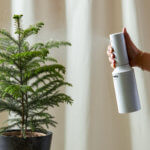First, let’s clean up your plant. This allows the plant to direct its energy to new healthy growth.
- Remove entire brown leaves (they will not turn green again) or the affected portion with a pair of sharp scissors or pruning shears.
- Wipe the blades of your scissors with rubbing alcohol between each snip.
- You may need to trim your plant in stages because you never want to remove more than 20% of the affected leaves at one time–this could shock your plant.
Now, let’s get your Spider Plant on the road to recovery.
Water quality
One reason your Spider Plant’s leaves are turning brown on the edges could be due to your tap water. Tap water contains salts, chlorine, minerals and fluoride – all of which can build up in the soil of your plant causing the tips of the leaves to burn and turn brown. One way you can remedy this is to use a water filtration system. If you do not have a filtration system available, leaving your water in an open container or sink overnight before using can help relieve some of the chlorine.
Increase the humidity
Your Spider Plant may also be turning brown from a lack of humidity. Increase the humidity around your plant by misting the leaves on a regular basis, using a pebble tray, or moving a humidifier nearby.
Incredibly dry soil
Your Spider Plant can dry out a bit between waterings, but be sure you’re not underwatering your plant. Keep a consistent watering schedule–water when the top 50% of the soil is dry.
If you accidentally let your Spider Plant’s soil dry out completely, you may see leaves go limp, droop, lose color, and possibly start to brown. If the soil is extremely dry all the way through the pot, a thorough soak is in order.
Here’s how to soak-water your Spider Plant:
- Place your plant in your sink or tub without the saucer. Fill your basin up with about 3-4″ of water. Make sure the water isn’t hot!
- Allow your plant to soak up water through the drainage hole in the bottom of the pot for at least 45 min.
- Feel the top of the soil after your plant has been soaking–has the water reached the top 2-3” of soil?
- If not all the soil feels saturated, water your Spider Plant slightly from the top of the soil to help speed up the saturation.
- When your plant’s soil is evenly damp, drain the sink/tub and allow the plant to rest while it drains thoroughly. Place the plant back on its saucer and back in its proper spot.










